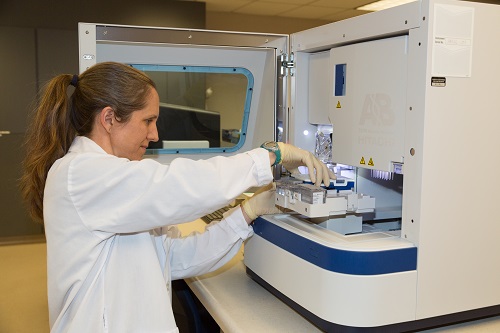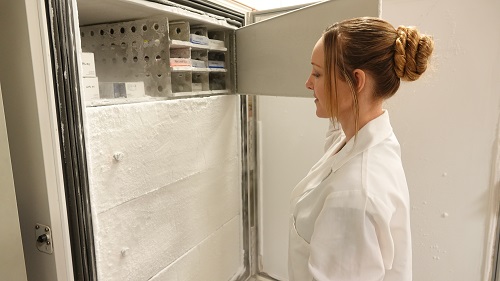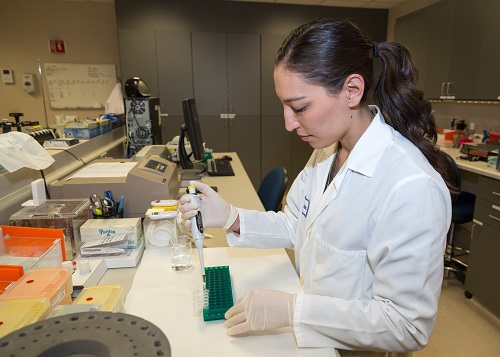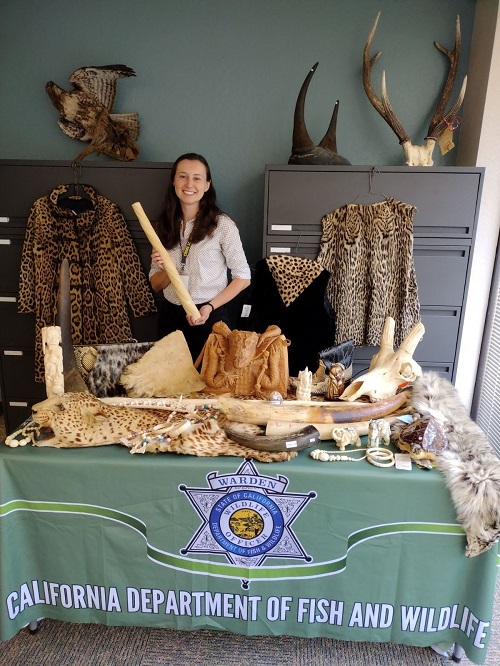Forensic Lab Overview
The Wildlife Forensic Laboratory (WFL) has been operating since the early 1950’s and supports CDFW Wildlife Officers by conducting forensic analyses on physical evidence for casework and public safety investigations. The term "forensic" is the application of science to the purposes of the law. The WFL serves as the wildlife “crime lab” for the CDFW Law Enforcement Division (LED) by providing scientific analyses to assist in the determination of whether wildlife laws have been broken. Over the years, the WFL has assisted Wildlife Officers with thousands of investigations into wildlife crimes such as poaching, trafficking, and illegally marketed products. The WFL fulfills a crucial and ever-expanding role in protecting California’s natural resources by using the most modern forensic techniques to support CDFW Wildlife Officers.
The WFL uses accepted forensic science procedures to examine, analyze, report, and testify on physical evidence seized by CDFW Wildlife Officers. The WFL staff participate in annual proficiency testing conducted by the Society for Wildlife Forensic Science (SWFS). The WFL is also involved with the national standardization of wildlife forensic protocols for species identification and DNA individualization. Additionally, wildlife forensic science requires the continued development and validation of forensic techniques and procedures for application to casework and to withstand adversarial legal challenges.
Forensic Lab Services
The primary function of the WFL is to conduct forensic analyses on physical evidence in criminal cases, civil cases, and public safety incidents involving wildlife. Depending on the type of sample and the analyses required, the WFL may perform a combination of serological, morphological and DNA testing. Biological samples submitted for testing include blood, tissue, hair, scat, saliva, hide, claw, feather, or ivory. The forensic analyses of such samples have directly assisted with field operations, justified search warrants, and helped prosecute poachers and other wildlife violators. The WFL staff provide legally admissible reports and expert testimony regarding investigation findings.
Most cases submitted to the WFL involve the use of DNA to determine the species, sex, and/or number of individual animals represented by case samples. The WFL also conducts morphological analyses on ivory samples to identify the species of origin and authenticity. During public safety wildlife incidents, the WFL uses DNA-based techniques to identify the offending wild animal.
The WFL provides a variety of services to CDFW Wildlife Officers, including the following:
Species Identification
- Abalone
- Birds
- Fish
- Horn-bearing
- Human
- Ivory-bearing
- Mammals
- Reptiles
- Sharks
Sex Identification
DNA Individualization (matching/exclusion)
- Black Bear
- Coyote
- Deer
- Elk
- Mountain Lion
- Wolf
AB-96 Ivory
The signing into law of Assembly Bill 96 (AB 96), now codified as Fish and Game Code (FGC) section 2022, made the commercialization of ivory and rhinoceros horn illegal in California, with limited exceptions. Passage of AB 96 prompted an allocation of dedicated Wildlife Officers, legal staff, and a Wildlife Forensic Specialist to work on issues related to the illegal trade of ivory and rhinoceros horn. Moreover, AB 96 funding supported the creation of the CDFW Genetics Research Laboratory (GRL). The GRL provides the laboratory space and specialized equipment necessary to conduct forensic research for direct application to law enforcement casework.
CDFW is the primary agency responsible for the enforcement of ivory and rhinoceros horn trafficking violations of state law. The WFL supports enforcement efforts by identifying the species of origin for confiscated items. The WFL staff are federally certified in the morphological identification of ivory using physical and chemical characteristics, and continue to make advances in the development of genetic markers to identify every ivory-bearing species listed under the definition of ivory in FGC 2022.
Forensic Lab Staff
Erin Meredith
 Erin Meredith, BSc., MSc., Senior Wildlife Forensic Specialist;
Public Safety, Population Genetics, and Individual Identification
Erin Meredith, BSc., MSc., Senior Wildlife Forensic Specialist;
Public Safety, Population Genetics, and Individual Identification
Erin.Meredith@wildlife.ca.gov
Erin Meredith is a Senior Wildlife Forensic Specialist. She joined CDFW as a Scientific Aid under the guidance of James Banks in 1999 while completing her BSc. and MSc. degrees in Genetics at the University of California, Davis (UC Davis). Erin aided in transitioning the WFL to DNA-based methods for individual identification in a variety of wildlife species. This work included the development and optimization of tetranucleotide short tandem repeat (STR) markers for California’s deer, elk, black bear, and mountain lions. Her thesis research focused on the creation and utilization of multiplexed forensic quality STR panels for casework and population genetic study of California’s elk subspecies. Guiding the evolution of each species’ specific genetic markers from their original development to their present status has been a career-long endeavor. Several of these panels have been adopted in other wildlife forensic laboratories across the US, with the aim of standardization and improved data sharing.
Erin’s casework focuses on public safety wildlife investigations and individual identification of native species (deer, elk, black bear, mountain lion, coyotes, and wolves). She is a member of the Organization of Scientific Area Committees (OSAC) - Wildlife Forensic Subcommittee, the Society for Wildlife Forensic Science (SWFS), and is an inductee to Phi Beta Kappa.
Ashley Spicer
 Ashley Spicer, BSc., MSc., Senior Wildlife Forensic Specialist;
Ivory, Trafficking, and Species Identification
Ashley Spicer, BSc., MSc., Senior Wildlife Forensic Specialist;
Ivory, Trafficking, and Species Identification
Ashley.Spicer@wildlife.ca.gov
Ashley Spicer is a Senior Wildlife Forensic Specialist. Prior to joining CDFW in 2012, Ashley worked in molecular biology and biomedical research laboratories conducting projects on assay development, species identification, population genetics, and evolutionary studies. She earned a BSc. in Biochemistry from the University of Victoria (UVic) in British Columbia and an MSc. in Forensic Science from the University of California, Davis (UC Davis). Her thesis research was conducted at the UC Davis Veterinary Genetics Laboratory Forensic Unit with a focus on determining the frequency of mitochondrial heteroplasmy present in canine biological samples such as hair, blood, and saliva to assist with forensic interpretations of similar biological samples obtained from crime scenes.
Ashley brought her experience with species identification and sequencing technologies to CDFW and has incorporated forensic DNA methodologies to taxonomically identify birds, reptiles, sharks, fish, invertebrates, and mammalian species in casework. She works closely to support the Wildlife Officers with forensic techniques to identify trafficked wildlife materials (native and non-native) and has testified as an expert witness in ivory identification.
Ashley serves on the Proficiency Test Board for the Society for Wildlife Forensic Science (SWFS) and as the Executive Secretary for the Wildlife Forensic Subcommittee within the Organization of Scientific Area Committees (OSAC) for Forensic Science.
Jillian Adkins
 Jillian Adkins, BSc., MSc., Wildlife Forensic Specialist
Jillian Adkins, BSc., MSc., Wildlife Forensic Specialist
Jillian Adkins joined CDFW as a Scientific Aid in 2014 and was hired as a Wildlife Forensic Specialist in 2016. She received a BSc. in Biological Sciences with a concentration in Microbiology and a minor in Chemistry followed by a MSc. in Biological Sciences with a concentration in Cellular and Molecular Biology from California State University, Sacramento. Her thesis research utilized high-throughput sequencing on Illumina’s MiSeq platform, and this project continues as an ongoing collaboration with Dr. Ami Bhatt’s laboratory at Stanford University.
Jillian’s casework focuses primarily on public safety wildlife investigations and individual identification of native species (deer, elk, black bear, mountain lion, coyotes, and wolves). She is a member of the American Society of Microbiology, the Wildlife Society, and an affiliate member of the Organization of Scientific Area Committees (OSAC) – Wildlife Forensic Subcommittee.
Nicole Slattengren
 Nicole Slattengren, BSc., MSc., Wildlife Forensic Specialist
Nicole Slattengren, BSc., MSc., Wildlife Forensic Specialist
Nicole Slattengren joined CDFW as a Scientific Aid in 2021 and was hired as a Wildlife Forensic Specialist in 2023. She graduated from the University of California, Davis with a BSc. in Biological Sciences in 2020 and a MSc. in Forensic Science in 2022. Nicole’s graduate thesis research involved proteomic species identification of exotic cats and its application to law enforcement. Currently, her research is continuing at CDFW where proteomic analysis is used on a variety of wildlife trafficked items across a wide range of species. This proteomic research also encompasses a multi-year research project in collaboration with the United States Fish and Wildlife Service (USFWS) and the University of California, Davis (UCD). In addition to proteomics, Nicole focuses on DNA analysis of ivory, sharks, and wildlife trafficked items.
Nicole is a member of the Society for Wildlife Forensic Science (SWFS), the American Association of Forensic Science (AAFS), and the California Association of Criminalistics (CAC). Nicole has presented her thesis research at professional conferences for all listed associations. She has also instructed at the CDFW Warden Academy and presented on wildlife trafficking at public and educational events.
Publications
- McLellan, M.J., Carrothers, K.L, & Spicer, A.M. (2022). Investigating the utility of a handheld X-ray fluorescence (XRF) device as a field test for suspected ivory. Forensic science international: Animals and Environments, 2, 100041.
- Spicer, A. M., Lucero, S.A., McLellan, M.J., Goodmiller, L.E., & Carrothers, K.L. (2021). Determination of the Volumetric Percentage of Ivory Content using 3D Modeling: Assessment of Composite Objects and Threshold Exemption Status. Forensic science international: Animals and Environments, 1, 100016.
- Carrothers, K. L., Goodmiller, L. E., McLellan, M. J., & Spicer, A. M. (2021). A novel approach to combatting proboscidean ivory trafficking using a multiplex High-Resolution Melt (M-HRM) assay. Forensic science international. Genetics, 53, 102511.
- Hamlin, B.C., Meredith, E.P., Rodzen J.A., & Strand, J. (2021) OdoPlex: An STR multiplex panel optimized and validated for forensic identification and sex determination of North American mule deer (Odocoileus hemionus) and white-tailed deer (Odocoileus virginianus). Forensic science international: Animals and Environments, 1, 100026.
- Meredith, E.P., Adkins, J.K., Rodzen, J.A. (2020) UrsaPlex: An STR multiplex for forensic identification of North American black bear (Ursus americanus),
Forensic Science International: Genetics, 44.
- Wendt, F.R., King, J.L., Novroski, N. M.M., Churchill, J.D.,Ng, J., Oldt, R.F., McCulloh, K.L., Weise, J,A,, Smith, D.G., Kanthaswamy, S., Budowle, B. (2017) Flanking region variation of ForenSeq™ DNA Signature Prep Kit STR and SNP loci in Yavapai Native Americans.
Forensic Science International: Genetics, 28: 146-154.
- McCulloh, K. L., Ng, J., Oldt, R. F., Weise, J. A., Viray, J., Budowle, B., Kanthaswamy, S. (2016). The genetic structure of native Americans in North America based on the Globalfiler® STRs.
Legal Medicine, 23, 49-54.
- Wendt, F.R., Churchill, J.D., Novroski, N.M.M., King, J.L., Ng, J., Oldt, R.F., McCulloh, K.L., Weise, J.A., Smith, D.G., Kanthaswamy, S., Budowle, B. (2016) Genetic analysis of the Yavapai Native Americans from West-Central Arizona using the Illumina MiSeq FGx TM Forensic Genomics System,
Forensic Science International: Genetics, 24: 18-23.
- Ng, J., Oldt, R.F, McCulloh, K.L., Weise, J.A., Viray, J., Budowle, B., Smith, D.G., Kanthaswamy, S. (2016) Native American Population Data Based on the Globalfiler® autosomal STR loci,
Forensic Science International: Genetics, pp. e12-e13.
- Vogel C.F., Chang W.L., Kado S., McCulloh K., Vogel H., Wu D., Haarmann-Stemmann T., Yang, G.X., Leung, PS, Matsumura F, Gershwin ME. (2016) Transgenic Overexpression of Aryl Hydrocarbon Receptor Repressor (AhRR) and AhR-Mediated Induction of CYP1A1, Cytokines, and Acute Toxicity.
Environ Health Perspect.
- Spicer, A.S., Kun, T.J., Sacks, B.N., Wictum, E.J. (2014) Mitochondrial DNA sequence heteroplasmy levels in domestic dog hair.
Forensic Science International Genetics 11: 7-12.
- Meredith, E.P., Rodzen, J.A., Banks, J.D., Jones, K.C. (2009) Characterization of 29 tetranucleotide microsatellite loci in black bear (Ursus americanus) for use in forensic and population applications. Conservation Genetics 10(3): 693-696.
- Pease, K. M. Freedman, A.H., Pollinger, J.P., McCormack, J.E., Buermann, W., Rodzen, J., Banks, J., Meredith, E., Bleich, V.C., Schaefer, R.J., Jones, K., Wayne, R.K. (2009) Landscape genetics of California mule deer (Odocoileus hemionus): the roles of ecological and historical factors in generating differentiation. Molecular Ecology 18(9): 1848 1862.
- Rodzen, J.A., Banks, J.D., Meredith, E.P., Jones, K.C. (2007) Characterization of 37 microsatellite loci in mountain lions (Puma concolor) for use in forensic and population applications. Conservation Genetics 8(5): 1239-1241.
- Meredith, E.P., Rodzen, J. A., Banks, J. D., Schaefer, R., Ernest, H.B., Famula, T.R., May, B.P. (2007) Microsatellite Analysis of Three Subspecies of Elk (Cervus elaphus) in California. Journal of Mammalogy 88(3): 801-808.
- Meredith, E.P., Rodzen, J.A., Levine, K.F., Banks, J.D. (2005) Characterization of an additional 14 microsatellite loci in California Elk (Cervus elaphus) for use in forensic and population applications. Conservation Genetics 6(1): 151-153.
- Aguilar, A., Banks, J.D., Levine, K.F., Wayne, R.K. (2005) Population genetics of northern pike (Esox lucius) introduced into Lake Davis, California. Canadian Journal of Fisheries and Aquatic Sciences 62(7): 1589-1599.
- Jones, K.C., Levine, K.F., Banks, J.D. (2002) Characterization of 11 polymorphic tetranucleotide microsatellites for forensic applications in California elk (Cervus elaphus canadensis). Molecular Ecology Notes 2(4): 425-427.
- Jones, K.C., Levine, K.F., Banks, J.D. (2000) DNA-based genetic markers in black-tailed and mule deer for forensic applications. California Fish and Game 86(2): 115-126.
- Gilson, A., Syvanen, M., Levine, K., Banks, J. (1998) Deer gender determination by polymerase chain reaction: validation study and application to tissues, bloodstains, and hair forensic samples from California. California Fish and Game 84(4): 159-169.
- Theis, J.H., deRopp, J.S., Schwab, R.G., Banks, J.D., Levine, K.F. (1988) Nuclear Magnetic Resonance to Differentiate Bear, Pig, and Cow Bile for Forensic Investigations. Wildlife Society Bulletin 16(4): 430-433. Published by Allen Press.